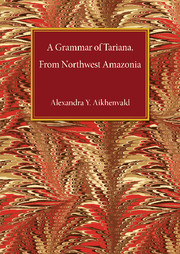Book contents
- Frontmatter
- Dedication
- Contents
- List of tables, schemes and diagrams
- Preface
- Acknowledgements
- Organisation and cross-referencing
- List of abbreviations
- Map
- 1 The language and its speakers
- 2 Phonology
- 3 Word classes
- 4 Nominal morphology and noun structure
- 5 Noun classes and classifiers
- 6 Possession
- 7 Case marking and grammatical relations
- 8 Number
- 9 Further nominal categories
- 10 Derivation and compounding
- 11 Closed word classes
- 12 Verb classes and predicate structure
- 13 Valency changing and argument rearranging mechanisms
- 14 Tense and evidentiality
- 15 Aspect, Aktionsart and degree
- 16 Mood and modality
- 17 Negation
- 18 Serial verb constructions and verb compounding
- 19 Complex predicates
- 20 Participles and nominalisations
- 21 Clause types and other syntactic issues
- 22 Subordinate clauses and clause linking
- 23 Relative clauses
- 24 Complement clauses
- 25 Discourse organisation
- 26 Issues in etymology and semantics
- Appendix. The main features of the Tariana dialects
- Texts
- Vocabulary
- References
- Index of authors, languages and subjects
8 - Number
Published online by Cambridge University Press: 05 August 2013
- Frontmatter
- Dedication
- Contents
- List of tables, schemes and diagrams
- Preface
- Acknowledgements
- Organisation and cross-referencing
- List of abbreviations
- Map
- 1 The language and its speakers
- 2 Phonology
- 3 Word classes
- 4 Nominal morphology and noun structure
- 5 Noun classes and classifiers
- 6 Possession
- 7 Case marking and grammatical relations
- 8 Number
- 9 Further nominal categories
- 10 Derivation and compounding
- 11 Closed word classes
- 12 Verb classes and predicate structure
- 13 Valency changing and argument rearranging mechanisms
- 14 Tense and evidentiality
- 15 Aspect, Aktionsart and degree
- 16 Mood and modality
- 17 Negation
- 18 Serial verb constructions and verb compounding
- 19 Complex predicates
- 20 Participles and nominalisations
- 21 Clause types and other syntactic issues
- 22 Subordinate clauses and clause linking
- 23 Relative clauses
- 24 Complement clauses
- 25 Discourse organisation
- 26 Issues in etymology and semantics
- Appendix. The main features of the Tariana dialects
- Texts
- Vocabulary
- References
- Index of authors, languages and subjects
Summary
Similarly to most Arawak languages, Tariana distinguishes singular and non-singular numbers. The Tariana number system is unusual in that (i) number oppositions and number distinctions depending on the type of referent, and (ii) number can be marked more than once within a grammatical word.
Number marking
Tariana nominais fall into six groups with respect to their number oppositions and number marking: countable nouns with an inanimate referent (§8.1.1), animate nouns (§8.1.2), kinship nouns (§8.1.3), uncountable nouns (§8.1.4), pluralia tantum (§8.1.5), and singulatives (§8.1.6). Associative plural is discussed in §8.1.7.
Inanimate nouns
Most countable nouns with an inanimate referent have three number distinctions. They are formally and functionally unmarked when number is not specified, and also have a collective sense. Explicit singular or non-singular reference is achieved by the addition of a classifier in a derivational function (as well as plural markers – Chapter 5) to the unmarked form. (This unusual number system is found in neighbouring languages, such as Tucano and Guahibo families: see Aikhenvald and Dixon 1999; it is most possibly an areally diffused feature.) Thus, the number distinctions cover:
(i) ‘general’, or collective: unmarked;
(ii) non-plural: singular/paucal, marked with a classifier in a derivational function;
(iii) plural: marked with a suffix -pe added to the classifier.
- Type
- Chapter
- Information
- A Grammar of Tariana, from Northwest Amazonia , pp. 164 - 182Publisher: Cambridge University PressPrint publication year: 2003



